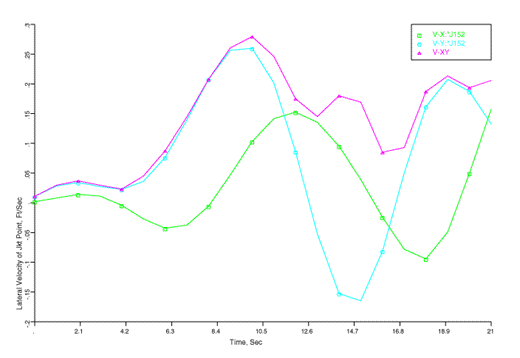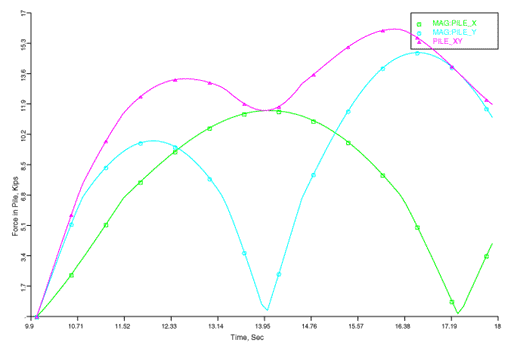The question of mating (or docking) is a rather broad one and
here, we will consider only a special case. In particular, we will
consider a body (which may be connected to the boom of a crane
vessel) which has been lowered to the proximity of the bottom of
the ocean. Now, we wish to connect this body to another body
(a template) which is already connected to the ocean.
 What we are really interested in finding out is the magnitude of
the connection forces during this process. Of course, these depend
strongly on the details of the operation. For our purposes, we can
consider this operation to consist of the following "stages".
What we are really interested in finding out is the magnitude of
the connection forces during this process. Of course, these depend
strongly on the details of the operation. For our purposes, we can
consider this operation to consist of the following "stages".
-
The body, moving freely, is positioned so that a pin can be
dropped into a stabbing cone on the existing body,
-
With a single connection to the bottom, the body is positioned
so that a second pin can be dropped, and
-
The body is lowered until all of its weight is being supported
by the ground.
One of the more interesting aspects of this problem is that one of
the larger connection forces may occur when one does not think
there is a connection. In other words, the pin may inadvertently
impact a part of the existing structure. To consider this possibility,
one should perform a time domain simulation, and find the
horizontal velocity of the stabbing pin.
 Now, you can find the maximum impact load by "connecting" a pile
to the pin and restarting the time domain a short time before the
maximum velocity occurred. Here, one needs relatively small time
steps to ensure that he gets close to the maximum impact load.
Now, you can find the maximum impact load by "connecting" a pile
to the pin and restarting the time domain a short time before the
maximum velocity occurred. Here, one needs relatively small time
steps to ensure that he gets close to the maximum impact load.
 After considering an accidental impact, one needs to get on with
finding the loads which will actually occur during the operation.
This requires an extensive analysis due to the number of cases
which should be considered. First, one normally needs to consider
sea states from several different directions. The real complication,
however, is that the stiffness of the connection changes as the
pins are lowered into the piles. In other words, before they are
engaged, there is zero stiffness and at maximum penetration there
is a maximum stiffness. For other levels of penetration, you have
something in between. The rational way to cope with this is to
treat the stiffness fraction (a fraction of the maximum stiffness)
as a parameter and perform each simulation for several (five
is a good number) values of it. Another possible complication
occurs when the diameter of the pin is small in comparison to that
of the pile. When this happens, there is local impact of the pin
with the pile and another nonlinearity to cope with.
After considering an accidental impact, one needs to get on with
finding the loads which will actually occur during the operation.
This requires an extensive analysis due to the number of cases
which should be considered. First, one normally needs to consider
sea states from several different directions. The real complication,
however, is that the stiffness of the connection changes as the
pins are lowered into the piles. In other words, before they are
engaged, there is zero stiffness and at maximum penetration there
is a maximum stiffness. For other levels of penetration, you have
something in between. The rational way to cope with this is to
treat the stiffness fraction (a fraction of the maximum stiffness)
as a parameter and perform each simulation for several (five
is a good number) values of it. Another possible complication
occurs when the diameter of the pin is small in comparison to that
of the pile. When this happens, there is local impact of the pin
with the pile and another nonlinearity to cope with.
We now have quite a number of cases to consider; 60 if we
look at 3 wave directions, 5 values of stiffness fraction, and
4 connection conditions. Doing this in the time domain normally
requires a substantial computational effort. An alternative is
to perform the parameter study in the frequency domain and check
a critical point or two with the time domain.



